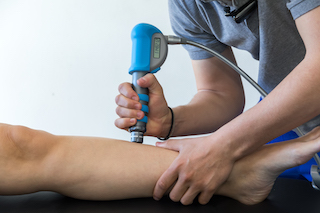Shock Wave Therapy is Making Waves In the Medical World!
Shock Wave Therapy is fast becoming the preferred method in treating Plantar Fasciitis, Shin Splints and Achilles Tendon Injuries. Over 45 different research studies indicate Shock Wave Therapy has a high success rate with these types of chronic conditions that often take a long time to respond with normal conservative management strategies. Most impressively, improvements are being reported within 5-7 visits!
If you’re not sure if Shockwave Therapy is the answer to your problem, you will have a fair idea after your first few visits if you’re a good candidate for this type of technology.
Should shockwave therapy not be the answer, don’t despair as Dr Ella Wright has many other treatment strategies to resolve your chronic foot, shin or heel pain that interferes with life’s simple pleasures.
How does Shock Wave Therapy work?
Shock Wave Therapy essentially consists of high-speed acoustic waves travelling through tissue, stimulating an inflammatory response in stubborn chronic conditions that just seem to hang about. It is not generally used for acute injuries as the body has already triggered an inflammatory response which is a normal initial response to any injured tissue.
Shock Wave Therapy triggers the “C nerve fibres” to release “Substance P” into the tissue as well as the spinal cord (Substance P is a neuropeptide that acts as a mediator/transmitter of pain information into the central nervous system). An easy way to remember it is, “P” for “Pain”. So initially Shock Wave Therapy causes slight discomfort but with prolonged activation (more than a few minutes), the C nerve fibre’s ability to release substance P diminishes which leads to a reduction of pain.
Our Podiatrist Dr Ella Wright is not interested in gimmicky expensive technology that tricks the body out of pain, but research is indicating it fosters healing by stimulating the release of growth factors and the activation of stem cells in the treated tissue…. very exciting prospect if the research is right! So in short, it triggers inflammation, numbs the pain whilst healing takes place in the background. Without the activation of stem cells, this technology would only be useful in managing chronic pain that has failed to respond despite all treatment efforts leaving the person dependent on pain killers for life. In short, Shock Wave Therapy offers real hope to heal chronic injuries and/or reduce/eliminate the reliance on pain killers.
The radial shock wave pressure has 2 phases:
- Phase 1: It begins by compressing creating shear stress in the tissue
- Phase 2: It follows a depression or tensile phase generating a cavitation bubble
The compressed air accelerates and strikes the applicator (gun-like handheld tool) at high speed (up to 90km/hr), the kinetic energy is converted into shock waves that are delivered to the target tissue through the skin at a therapeutic depth of 3-5 cm. Depending on the model of the machine and/or the type of applicator, it can reach up to 5-7cm so an important consideration for the larger persons as the 3-5 cm penetration may fall short on its mark rendering the treatment ineffective due to user error.
Shock Wave Therapy Contraindications
Shock Wave Therapy should never be applied to lungs or gut (air-filled tissues), ruptured tendons, pregnant women, kids under 18 yrs (except for Osgood-Schlatter), thrombosis or any other blood clotting disorder, persons on anticoagulants, tumours, infections or persons currently treated with cortisone. Providing these contraindications are met, there have been no reports of any harm, so the worst-case scenario is, there will be no change.
Shock Wave Treatment Protocols
All the research suggests that anywhere between 5-7 sessions as each session reduce P Substance incrementally whilst healing takes place in the background. It is also thought the acoustic waves shake up messy randomly laid scar tissue allowing new scar tissue to be laid down in a more orderly fashion reducing the restriction of individual soft tissue fibres. A well-planned rehab program ensures the new scar tissue develops along the natural fibres of the muscle and tendon not across as this hampers and restricts the natural movement of recovering soft tissue fibres. Treatment recommendations are based on the research conducted on different types of injuries but like all treatment recommendations, it is a guideline only as some people will respond immediately whilst others need more sessions and others will have no favourable clinical outcomes.
General treatment frequency recommendations for Shock Wave Therapy
All the research suggests no less than 72 hours (otherwise too much inflammation is stimulated) and no greater than 7 days (as substance P levels will start to rise again). If a person hasn’t felt any reduction in pain within 5-7 visits, they are most likely not a good candidate for this technology. If improvement is occurring, then further sessions would be warranted.
If you suffer from Plantar Fasciitis, Shin Splints or Achilles Tendon Issues, call the clinic and book an appointment with Dr Ella Wright

